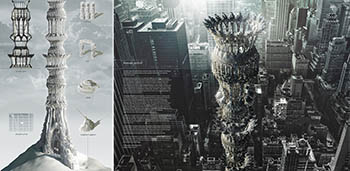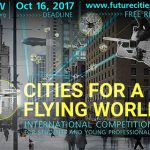eVolo Magazine is pleased to announce the winners of the 2017 Skyscraper Competition. The Jury selected 3 winners and 22 honorable mentions from 444 projects received. The annual award established in 2006 recognizes visionary ideas for building high- projects that through the novel novel use of technology, materials, programs, aesthetics, and spatial organizations, challenge the way we understand vertical architecture and its relationship with the natural and built environments.
The FIRST PLACE was awarded to Pawel Lipiński and Mateusz Frankowski from Poland for the project Mashambas Skyscraper. The design proposes a modular and scalable skyscraper conceived as an educational center and marketplace for new agricultural communities in sub-Saharan Africa. The design seeks to increase farming opportunities and reduce hunger in these regions.
Vertical Factories in Megacities designed by Tianshu Liu and Lingshen Xie from the United States received the SECOND PLACE. The design investigates the benefits of moving factories back to megacities. The proposal calls for a series of alternating architectural layers- factories and recreational areas stacked together to create a vertical structure. Each recreational layer would feed from the waste and resources of these factories.
The recipient of the THIRD PLACE is Javier López-Menchero Ortiz de Salazar from Spain for the project Espiral3500. The project introduces the streets and complexity of the city’s horizontal plane into a spiraling vertical structure.
The 22 honorable mentions include skyscrapers inside giant sequoias, villages embedded and hanging from mountains, automated plug-in cities, iceberg skyscrapers that reverse global warming, and wind harvesting structures among other fascinating projects.
/ Mashambas Skyscraper /
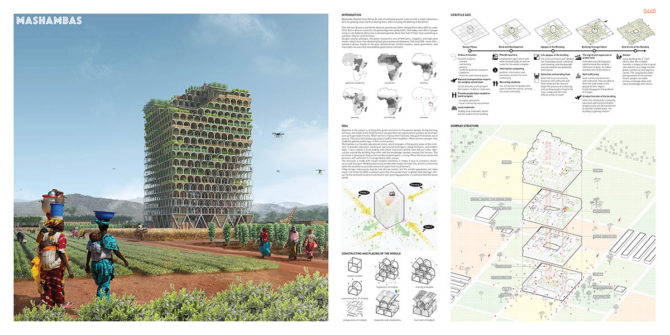

Over the last 30 years, worldwide absolute poverty has fallen sharply (from about 40% to under 20%). But in African countries, the percentage has barely fallen. Still today, over 40% of people living in sub-Saharan Africa live in absolute poverty. More than half of them have something in common: they’re small farmers.
Despite several attempts, the green revolution’s mix of fertilizers, irrigation, and high-yield seeds—which more than doubled global grain production between 1960 and 2000—never blossomed in Africa, because of poor infrastructure, limited markets, weak goverments, and fratricidal civil wars that wracked the postcolonial continent.
The main objective of the project is to bring this green revolution to the poorest people. Giving training, fertilizer, and seeds to the small farmers can give them an opportunity to produce as much produce per acre as huge modern farms. When farmers improve their harvests, they pull themselves out of poverty. They also start producing surplus food for their neighbors. When farmers prosper, they eradicate poverty and hunger in their communities.
Mashambas is a movable educational center, which emerges in the poorest areas of the continent. It provides education, training on agricultural techniques, cheap fertilizers, and modern tools; it also creates a local trading area, which maximizes profits from harvest sales. Agriculture around the building flourishes and the knowledge spreads towards the horizon. The structure is growing as long as the number of participants is rising. When the local community becomes self-sufficient it is transported to other places.
The structure is made with simple modular elements, it makes it easy to construct, deconstruct and transport. Modules placed one on the other create the high-rise, which is a form that takes the smallest as possible amount of space from local farmers.
Today hunger and poverty may be only African matter, but the world’s population will likely reach nine billion by 2050, scientists warn that this would result in global food shortage. Africa’s fertile farmland could not only feed its own growing population, it could also feed the whole world.
/ Vertical Factories is Megacities /
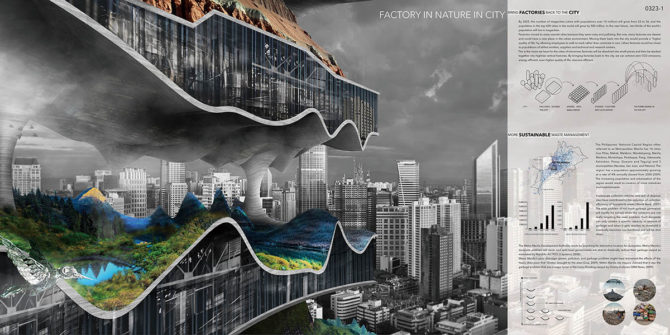

By 2025, the number of megacities, cities with a population over 10 million people, will grow from 23 to 36, and the population in the top 600 cities in the world will grow by 500 million. In the near future, two-thirds of the world’s population will live in these megacities.
Factories moved to areas outside cities because they were noisy and polluting. But now, many factories are cleaner and could have a new place in the urban environment. Moving them back into the city would provide a higher quality of life, by allowing employees to walk to work rather than commute in cars. Urban factories would be closer to populations of skilled workers, suppliers and technical and research centers.
This is the vision we have for the cities of tomorrow: factories will be dissolved into small pieces and then be stacked together into high-rise vertical factories. By bringing factories back to the city, we can achieve zero CO2 emissions, be energy efficient, and provide higher quality of life to the inhabitants.
Sustainable waste management.
The Philippines’ National Capital Region, Metropolitan Manila, has 14 cities (Las Piñas, Makati, Malabon, Mandaluyong, Manila, Marikina, Muntinlupa, Parañaque, Pasig, Valenzuela, Kalookan, Pasay, Quezon and Taguig) and 3 municipalities (Navotas, San Juan, and Pateros). The region has a population approximately growing at a rate of 4% annually; the increasing population and urbanization of the region results in the creation of more industries and establishments.
Inadequate collection vehicles and lack of disposal sites have contributed to the reduction of waste collection efficiency. The main problem of too much garbage generation will hardly be solved when the solutions are not really targeting the main problem. Each dumpsite can only contain a specific capacity or amount of garbage and when it gets reaches its threshold it eventually becomes non-functional and will be shut down. The Metro Manila Development Authority reacts by searching for alternative location for dumpsites. Metro Manila’s dumpsite problem will never end until local governments are able to drastically reduce their garbage output as mandated by Republic Act 9003.
Metro Manila’s poor drainage system, pollution, and garbage problem might have worsened the effects of the heavy downpour that ‘Ondoy’ brought to the area. Metro Manila city mayors claimed that it was the garbage problem that was a major factor in the heavy flooding caused by Ondoy (Calonzo GMA News, 2009).
Bring nature back to the city
Due to the large population in Manila, a great amount of organic waste is produced daily. This waste will be the resource of the new vertical factory. All the waste will be dumped at the bottom level of the factory, and then they will be transformed into valuable products including water, fertilizer, heat, and electricity. We use these products to create different kinds of natural environment. The landscape is shaped according to the scale and shape of factories. Organic waste then can be turned into new city landscape while factories hide beyond natural surfaces. The main concept of this design is to let people be aware of the truth that the natural environment is a loop, everything you produce will then form the new world. Instead of criticizing the pollution problem we create the most ideal way for people to understand the best interaction between human and nature.
/ Espiral 3500 /


The eastern coast of Spain, containing the most highly populated seafront areas in the country, has suffered an indiscriminate urban expansion. Criteria for construction have erred on the speculative side rather than being the rational consequence of studying the urban needs of the territory.
Espiral3500 is situated in “La Albufera”, an agricultural natural park which has been subjected to speculation based development and expansive growth. Tourism has become the main force of attraction. With it, it has produced an urban sprawl, which has disfigured the landscape. Tourism in the area causes an increase in population density of up to 1000% in some localities, turning them from ghost towns in winter to areas of high most density in summer.
Would a more coherent model have been possible in “La Albufera” given knowledge of its operation?
A model that advocates management of the territory and its demands over selling its most precious good, the land; this is where the typology of the skyscraper becomes relevant as a figure that can absorb most of the anxieties and demands of the population. This element would be capable of seeing to the touristic needs without greatly affecting the natural resources of the territory. The gaps produced by the cyclical nature of tourism in the vertical construction could result in additional maintenance costs. However, the gaps experienced during winter in territories of the extensive model leave a far more devastating scenery behind, producing a total disassembly of most services and urban functions due to reduction of their density.
What type of skyscraper should be introduced?
The successful level repetition skyscraper model of the 20th century must be transformed. To this end, I focus on initial theories on verticality, in which the concept of verticality is seen as the possibility of reproducing and extending all that happens at ground level.
Then, why not place public spaces inside buildings? This tower would no longer be an element where solely private dynamics take place. The Spanish eastern coast city is the quintessential city of public and open spaces. This skyscraper explores the interesting standpoint of introducing the streets and all of the city’s horizontal plane complexity into the vertical realm.
The main investigation of this project is to understand the relationship between and the role played by private and public spaces within the skyscraper. Here, I use a spiral system in which the public spaces (namely the different types of streets) form rings that rest on a structural element. Spaces for private use hang from this structural element. This “inverted street” system allows for an immediate linking of public and private, while allowing for sufficient dissociation to grant desired privacy.
/ Arch Skyscraper /
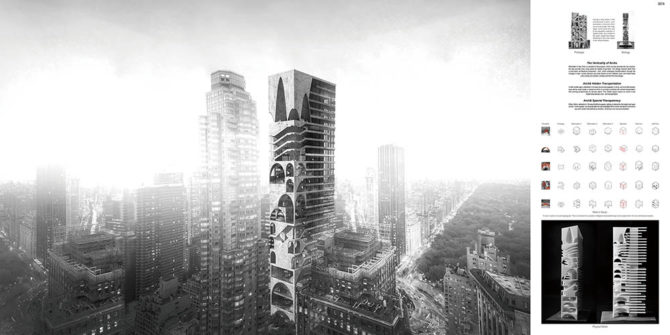
Manhattan is a paradise of skyscrapers, which not only decorate the city’s skyline, but also provide more usable space for people living there. This design scheme starts from a most basic architectural component, an arch that undergoes transformations through the changes of light, human behavior, and other factors to form different spaces/units, which overlap one another vertically to form the final design.
Arch and hidden transportation
In both, Middle Ages cathedrals in Europe and ancient pagodas in China, we found that double-layer arches could create a mezzanine, which we cunningly combined with vertical transportation, which works exceptionally well to service spaces. This hidden space inspire us invent a new relationship between arch and transportation.
Arch and spatial transparency
Either in a Gothic cathedral or a Chinese Buddhist pagoda, lighting is altered by the height and span of arches. In this project, we reconsolidate the acknowledged form of the arch and tend to reinvent a new arch system that is defined by direction, dimension, and memorial distortion.
/ The Forgotten Memorials: The Utopian Future of Urbanization /

Tracing back to two hundred years ago, urban growth came with the demolition of old buildings, which then were replaced with clusters of new larger and denser buildings. The original residents, in many cases, were forced to move out and were reimbursed for a monetary loss. Urbanization was based on this constant cycle.
Today, however, there is a new era that people have been waiting for but was not imagined. Contrary to demolishing old buildings to achieve urbanization, the early generation legislated a rule that all of new constructions cannot be built at the sacrifice of demolishing old ones. The past buildings remain in physical forms various mirrors to tell who we used to be and where we had been. As a return, the original residents of old buildings are able to stay, to hold high value of properties, and to enjoy the majestic view. In order to keep the past and to accommodate the future on limited land, every generation starts to construct new buildings from the bottom of existing ones. Consequently, older buildings constantly rest on top of newer blocks. They gradually, generation by generation, penetrate clouds and become memorials beyond the sky.
/ Heal-Berg: Reverse Climate Changing Machine /
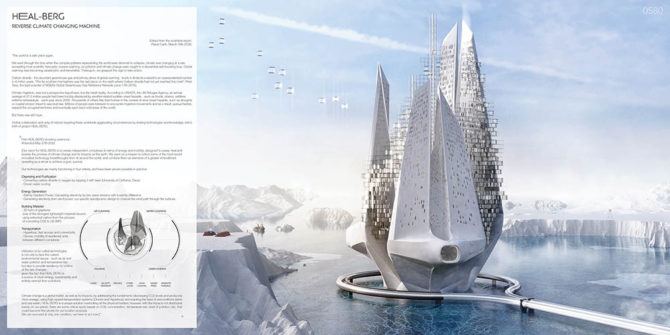
We went through the time when the complex patterns representing the world were doomed to collapse, climate was changing at a rate exceeding most scientific forecasts; oceans warming, air pollution and climate change were caught in a discernible self-boosting loop. Global warming was becoming catastrophic and irreversible. Thereupon, we grasped the urge to take action.
Carbon dioxide – the abundant greenhouse gas and primary driver of global warming – levels in Antarctica raised to an unprecedented number in 4 million years. “The far southern hemisphere was the last place on the earth where Carbon dioxide had not yet reached this mark”, Peter Tans, lead scientist, NOAA’s Global Greenhouse Gas Reference Network (June 2016).
Climate migration, was not a prospective hypothesis, but the harsh reality. According to UNHCR, the UN Refugee Agency, an annual average of 21.5 million people had been forcibly displaced by weather-related sudden onset hazards – such as floods, storms, wildfires, extreme temperature – each year since 2008. Thousands of others flee their homes in the context of slow-onset hazards, such as droughts or coastal erosion linked to sea level rise. Millions of people were foreseen to encounter migration movements and as a result, pursue habitat, expand the occupied territories and eventually spoil intact wild areas of the world…
/ Adaptive Capacity: A Socio-ecological Vertical Community in Tanzania /
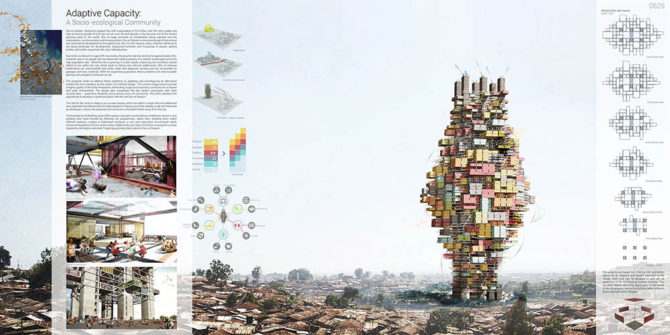
Dar es Salaam, Tanzania’s largest city, with a population of 4.5 million, with the city’s stable and high economic growth of 6.5% per annum over the last decade, it has become one of the fastest growing cities in the world. Due to large amounts of investments being injected into the construction, communication and mining sectors, Dar es Salaam is now prioritising infrastructural and commercial developments throughout the city. For this reason, many informal settlements are being destroyed for development, displacing hundreds and thousands of people, getting further and further away from the city’s infrastructure.
Due to Dar es Salaam’s huge shift in economy, the poverty rate has declined to approximately 28%. However, one in six people still live below the national poverty line, almost unchanged due to the high population rate. While the city is growing, it is also rapidly urbanizing, but countless cannot afford to live within the city which leads to falling into informal settlements. 80% of informal settlements are overcrowded, lack clean water and adequate sanitary and are surrounded by garbage and toxic materials. With the expanding population, these problems will only escalate, putting more people’s livelihoods at risk.
The proposal seeks to address these problems by adapting and reconfiguring an alternative solution for slum-dwellers, by the means of a ‘Vertical Village’. This vertical village aims to provide a higher quality of life to the inhabitants, eliminating rough and unsanitary conditions for a cleaner and safer environment. The design also recognises the key factors associates with slum communities – autonomy, flexibility and a strong sense of community. This offers dwellers the opportunity to develop in synchronisation with the rest Dar es Salaam.
The boundaries of dwelling, work/office spaces, education and childcare, healthcare, leisure in one building have been blurred by diffusing the programmes, rather than isolating them within different sections, creates a distributed resilience, a rich and interactive environment which echoes atmospheres of slum communities. Additionally, each type of function is assigned a colour inspired by the highly saturated Tingatinga painting style, native to Dar es Salaam.
A vast amount of high-rise buildings in hot climates mimic western models with sealed facades, reliant on air-conditioning and have little solar shading. This proposal intends to protect inhabitants and take advance of the weather conditions of Dar es Salaam. The building provides a naturally ventilated, perforated, indoor-outdoor and shaded model to suite the tropical climate.
The project is modeled by slum-dwellers autonomous lives, by being self-sufficient, in mimicking nature’s closed loop system. The Vertical Village is constructed above an unused swamp, which will take advantage of the water by the means of agriculture and aquaculture. Small pods are used to create nested ecologies, broadening the variety of vegetation grown in Dar es Salaam and Tanzania, offering people a more nutritious diet.
A crucial part of the scheme is to teach occupants about safer and cleaner living, so they can share the knowledge and skills they have been offered to other communities. Small hubs of work stations, dwellings, leisure, childcare and healthcare facilities will be erect in and around the city and further, creating translocal, transnational and transglobal civic networks between poor communities.
/ Earth Port One /
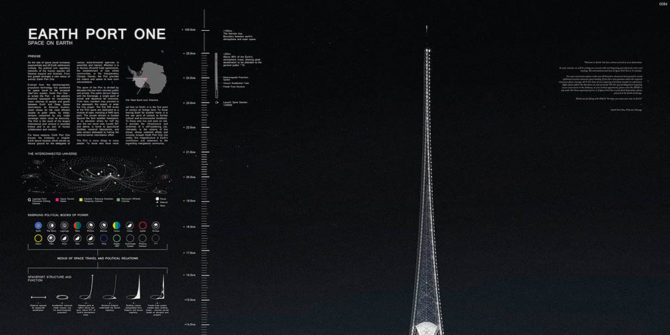
As the rate of space travel increases exponentially and off-Earth settlements multiply, the political and regulatory networks of the human species will likewise expand and diversify. From this growth emerges a new nexus of activity: Earth Port One.
Evolved from the electromagnetic propulsion technology first pioneered for space travel in the ancestral StarTram system, Earth Port One – or simply the Port – is the planet’s foremost spaceport for transporting mass volumes of people and goods between Earth and Deep Space destinations. Its Antarctic location, which allows for the most efficient access to polar orbits, by treaty, remains unclaimed by any single sovereign nation since its discovery. The Port is the result of the largest international joint venture in recorded history and is an icon of human collaboration and creation.
For these reasons, Earth Port One houses the Embassy: a singular Earth bound location which serves as neutral ground for the delegates of various extra-terrestrial agencies to assemble and interact. Whether it is to discuss off-world trade agreements, the establishment of new orbital communities, or the Interplanetary Olympic Games, the Port provides the means and space to host such conversations.
The spine of the Port is divided by elevation into two main volumes: public and private. The public domain begins with the Exchange, a single point of arrival and departure for everyone. From here, travelers may proceed to the spaceport, the airport, or enter the City proper. The first 500 levels of the Port spine are dedicated to a mixture of uses, including a 1600 acre park. The private domain is located beyond the 9km weather breakpoint, at an elevation where for half the year the sun never sets. Levels 501 and above, is home to agricultural facilities, research laboratories, and data centers dedicated to fueling the extra-terrestrial colonization effort.
The Port is many things to many people. To those who have never set foot on Earth, it is the first point of contact on foreign land. To those leaving Earth for another home, it is the last point of contact to familiar cultural and environmental conditions. To those who live and work on site, it provides the infrastructure and amenities of a self-sustaining city. Ultimately, to the citizens of this planet, whose collected efforts and curiosity brought Earth Port One into reality, this megastructure is Earth’s contribution and statement to the expanding intergalactic community.
/ The Silver Lining: Reconstructing Post-War Syria /

Currently known as the worst humanitarian crisis of our time, the on-going Syrian civil war has not only eroded the nation in its entirety but also defaced its cultural identity. Over 11 million people have been displaced in the last five years and 4.8 million refugees have been forced to seek protection in neighboring countries, resulting in a continental scale exodus. What was once a land with a rich history and diverse culture is now a war-torn nation reduced to rubble.
In response to the existing ruined city fabric and architecture, ‘The Silver Lining’ concept proposes a radical approach of process driven conversion of post-war debris into a myriad of raw building material. The proposed mega form line establishes a colossal yet sublime presence above the broken city, adjoining the crumbled fabric through extreme horizontality. The proposal extracts the debris from the city into the mega form 200m above ground level and then deposits it under a series of systematic processes from which the reformed material will be placed back onto ground zero for construction.
This procedure is distinct and isolated from the post war wreckage; to accentuate the creation of the new city typology from the old. The new city will rise above the debris of war to give the Syrian capital: Damascus a new beginning.
The materials used in the building industry and its associated solid wastes account for around half of the wastes generated worldwide. Furthermore, building materials have an environmental impact at every step of the building process; extraction of raw materials, processing, manufacturing, transportation, construction and disposal of material at the end of a building’s life. This project recognizes the immense reserves of building rubble as a result of the war activity and attempts to reprocess it into concrete and distribute it around the affected areas of the city. Current practices of concrete reprocessing involved uncomplicated and well-established crushing techniques which is adopted at a large scale in the proposed mega form.
Alongside the debris conversion, the mega form will in conjunction begin to re-establish a natural landscape by the collection and distribution of water and soil beginning from under its footprint. This secondary function is vital in reconstructing the Syrian agricultural industries thus, aiding the economy to become self-sustaining. The landscape footprint will gradually increase creating a public park for the people of Syria to use for daily activities, agriculture and extract additional building materials.
Future use
The primary purpose of the mega form will be complete once the convertible material has been depleted and recycled into usable building material for the city. The empty mega form can then be retrofitted to become an extension to the Damascus city fabric for various uses the city may be presented with.
The large spaces that were used in converting debris can be adaptively re-used into civic spaces, tertiary institutions, religious sanctuaries, accommodation or new work places. Becoming a usable and reusable typology, allows Syria to revitalize and support its future economy and livelihood.
With it’s restored urban identity, stretches of Damascan skies will be filled with streaks of silver; a beacon to the scattered Syrians to return back home.
/ Flexible Materials Skyscraper /

Nowadays, the construction of the building needs a lot of time, manpower, and working procedure. A variety of buildings are formed through being assembled with different materials. However, the changeless rigid material has not been able to meet the people’s pursuit of the architectural form, and the complex construction process also limits the development of the building. So we hope to explore a new architectural model to meet people’s pursuit of architectural form while reducing the tedious construction process. Draping – just like putting on clothes for a building, which are tailor made from inside to outside. We hope to find out a new material which can be arbitrarily folded, cut, enclosed, sewed, turned over, and falls into a pattern. Tower just shows such a concept and form. Most of its exterior spread like vertically carpet from its top floor, the local contraction showing a part of the internal details. In addition, its interior is assembled with more detailed small units. This method not only makes the construction of the building more convenient and simple, makes the building repaired easily, but also makes the material easily reused and recycled after the demolition.
As a result, the building will be able to developed more possibilities, the burden that formed for modeling reduced in the aspect of structure, so the method is more convenient for the construction process and for recycling to reuse, which solves the problem that the vast majority of construction waste, and also brings people a new space experience.
/ Human Castell /
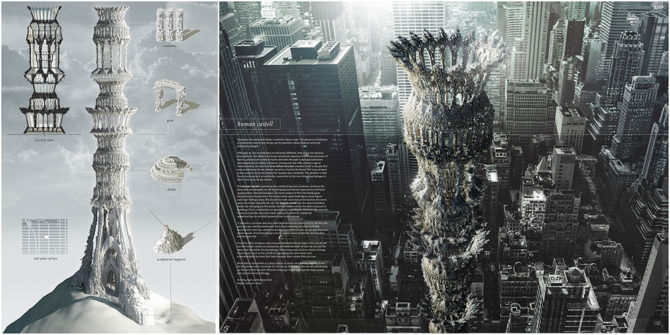
Senseless, disconnected blocks crowd the urban scape. The absence of dialogue, of emotional connection, brings up the question: where does art end and architecture begin?
Although art and architecture are distinctly different, they share one obvious characteristic: the ability to activate emotional response. In its thousand years of history, architecture spoke of myths and tales through sculptural expression, and tapped into its ability. However, coming into the 20th century’s age of mechanization, the doctrine ‘form follows function’ manifest itself so deeply that now, architecture of raw, honest narrative is hard to be found. The issue at hand in the modern city is not simply the “modern box” aesthetic. The problem is that these structures lack an authentic connection to the ever-changing dialogue in which they exist. To our stories.
The human castell, inspired by the castells of ancient Catalonia, continue the story that was abruptly cut off. By bringing back formal expression in full force supported by new technologies, the tower begins to fill in the blank page.
Using the pure human form the tower builds upon itself, figure upon figure, each layer telling a story. Rid of exterior walls and obstructive barriers the tower opens its insides towards the city. The human castell flips the typical building inside out, bringing out the stories that are hidden within the dark enclosure of buildings. This is enabled by our developing technologies, the forms become the stories but also the structure itself, voiding the need for additional superstructure so no small gesture is lost in translation.
It presents a concrete and very solid depiction of our society as it is: the fear, the pain, the joy, and the excitement. Each layer enriching the other to finally become the most raw, unobstructed representation of who we are and what our stories create. At last breathing a much needed sense of identity and emotion into the grey city.
From the office windows and cramped apartment blocks high in the city sky we see the human castell, an enchanting yet solid reminder of who we are and the value that lies within this knowledge. When times pass and our stories change, more towers such as the castell rise up, telling the new stories and acknowledging the ones that have brought them where they are now.
More than a monument or a busy cluster of stories, the human castell is a cue for the present and a reminder for the future. Recording who we are and picking up the story that was left off far too long ago, that is perhaps the most crucial plot we have missed till now.
/ Mountain Skyscraper in Yosemite /

The Mountain is a skyscraper located in California at Yosemite National Park. The structure reaches almost 3,000 feet in the year and is conceptualized to exist congruously with the existing environment.
Concept
The illusion of separation between man and nature continues to be perpetuated in the zeitgeist of a culture where forward thinking and technological advancement come at the expense of our environment. A relationship constrictively defined as occupant (man) and habitat (nature), the general consensus is that one is recurrently intruding on the other. In the pursuit to reconcile this dichotomy, The Mountain generates a spacial and functional relationship between context and program. To cultivate a harmonious environment, the structure combines synthetic and natural resources that equilibrate the necessities of man and nature.
Architecture
The Mountain takes the primitive idea of naturally cavernous space and combines it with the form of a modern skyscraper. Using a grid to establish a framework for the design, the mountain cliffside becomes the host for the spaces to be carved out of. These extrusions are negative spaces embedded in the towering natural structure of the earth. Individually, the habitats are able to occupy different programs varying in scale. When aggregated together the volumes form a monolithic skyscraper reaching thousands of feet into the the air.
Program
Against the background of a natural environment, the project seeks to encourage observation, exploration, preservation, and research. As an Observatory and Conservatory, science becomes the foundation for the program to thrive. It can respect a sensitive natural landscape and support mankind’s curiosity for knowledge and discovery. The goal is to begin an architectural typology that exemplifies the potential for a balanced environment. The Mountain draws from a primitive design concept, but in doing so is able to achieve a built environment that is forward-thinking in a natural and technical way.
/ Giant Sequoia Skyscraper /

Human desires are endless and incapable of coexisting with nature. Crying in agony, nature seems to fight back with worldwide natural disasters. Deforestation is one of the worse crimes on nature and also one of the main causes of natural disasters. Now it is the time to change, to stop exploiting nature and find equilibrium.
The Giant Sequoia in the United States, worshipped by the Native Americans, has been mercilessly destroyed by modernization. Global warming has increased the breeding rate of pests and has shortened the life span of these trees. Moreover, the Giant Sequoia with enormous volume and height does not grow deep roots. When the heartwood, or the structural backbone start to rot, they fall dead by its own weight.
This project attempts to show a new architectural approach to human coexistence with nature, in harmony with the nature’s temporality. The architecture quietly takes place in the empty void of trunks, without hindering the breathtaking landscape formed by the giants. It then becomes active as an artificial organ to replace the trunks rotten away. Only occupied in the void is the minimal gesture necessary for human occupation.
The project attempts to educate visitors about these natural wonders while feeling infinitely small among these giant creatures of 100 meters in height and of 27 centuries of history.
Kristina Rykova
/ Acupuncture of Urban Traffic Structure /

Moscow can’t breathe anymore due to non-stopping traffic jams. The transportation system needs to be improved- radical solutions are needed. The analysis revealed the problem of the underground transportation system is that they lack connection to some metro branches, there are long intervals between trains, and problems with transfers between the stations are frequent. There is also the problem of inability to get from one periphery area to another without passing through the center, that is, the so-called pendulum movement “from the periphery-to the center-to the periphery”.
This problem can be solved by the formation of a new transportation system and the emergence of a new type of transport. To solve this problem has been created additional chords to the existing system on which the train will move. This is a string-rail system, located on poles, like a monorail, but is more environmentally friendly, low-cost, allowing to develop more speed and allow to set support poles wide apart.
Transportation chords will connect disjoint metro station and highway, at the intersection of which must be located multifunctional transport hub, including not only transferring from one type of transport to another, but also the social and cultural functions which are needed in this area. Also multifunctional object should become a new attraction point in the area. The location of the transport hub has been selected at the Vykhino metro station. This is the busiest station of the Moscow metro, because it is the intersection of railways and subways. Also monotonous types of buildings dominate this area and it does not have its point of attraction.
/ Sustainable Urban Mining Factory Skyscraper /

New York, the densest and largest city in the World, is also widely reported to be the most wasteful in terms of garbage, water use and energy. It generates 14 million tonnes of waste each year and spends $2.3 billion per year disposing it off. Until 2001 nearly all of NYC waste ended up in landfill in the borough of Staten Island. Since its closure the garbage is transported to landfills elsewhere. This approach is only diverting the problem and fails to recognize that the reason for excessive amount of waste is not only the sheer size of the city but is mostly a result of consumer-throwaway culture. The magnitude of this manifestation of wastefulness is amplified with the density. Manhattan, the densest county in America, generates 2400 tonnes of waste alone every day.
There is a constant flow of products into the busy city centre and at the same time a flow of waste going out. This waste is scarcely recycled due to lack of public recycling facilities and either ends up in landfill or if recycled, the raw material, goes as far as China to be used in manufacture again. This results in pollution due to transport. This consumerism and wastefulness cycle continues on a global scale.
Urban Mining Factory is a vertical recycling factory in the heart of the city. A factory which turns trash to product. Process is focused on the materials and waste of the city such as paper, plastic or food and turning those into products and fuel that the city needs.
The essence of the project is to create closed loop cycle for as many materials-products as possible. The tower focuses on the things that city is using the most. Building celebrates the process of reclaiming materials, manufacturing and then selling the products.
New York’s problem with waste could be solved by recycling but foremostly by waste reduction. Positioning a recycling tower in the middle of Manhattan would not only promote recycling, educate people of New York about its importance and make them aware what happens to all their waste, but also cut down the cost and emissions of diesel burned to transport garbage out of the city to landfill and also transport the products into the city.
By its exoskeletal nature with exposed services and processes to the outside, the building serves as a noble impulse to the modern World. Its form is derived from the process taking place inside, changing from top to bottom, from raw to product. Furthermore, the form is a celebration of the process and it provides visitors an opportunity to experience it.
It is a vision to redefine the capitalist image, a symbol of responsible consumption, a modern icon of progressive society.
/ Vertical Traditional Chinese Village /

For a long time, ancient Chinese people have unlimited desire for the mysterious sky. Many years ago, China experienced the era of exploring the high-rise building, such as high-platform building, Tasha, and so on, even our ancient emperor Wei also want to build a super high palace. All of the stories show our ancestors’ aspirations and creative ideas for the high-altitude buildings. Cultural inheritance is considered as a significant design element in the development of exploring the high-rise buildings. We should solve the ecological issues by using our science and technological methods and try our best to preserve our historical cultures.
Human destroy nature, break and disorder the balance of original ecological system. Our plan try to consider architecture as a special medium to better the relationship among human and nature and recover the balance of ecological system.
We use the traditional design forms to solve the environmental problems and preserve the regional cultural context. Analyze and reorganize the functions in multiple ways to create a living complex with the local cultural significance. We try to use Chinese painting comfortable and free expression forms to plan and design architecture to strengthen the contacts between different people, human and nature.
Our plan creates a modular relationship between the part and the whole of the project by applying the unique timberwork to the design. It is similar to the relationship between wood structure, brackets and small components of windows and doors in the design of stupa. All of the components maintain their own independence and have different metabolic cycles. It forms a kind of “vertical village”based on culture. Building treatment is considered as an “unfinished form” to adapt to the development and dynamic change of city.
/ The Scaffold of Babel /
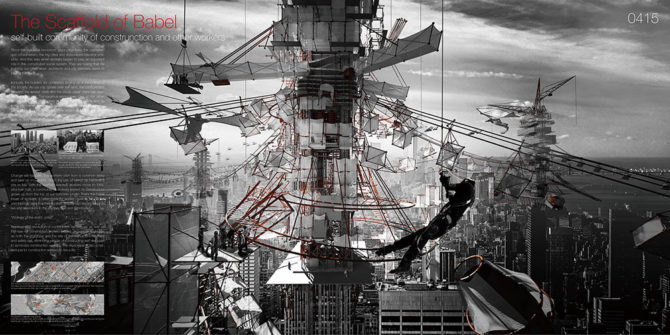
Since the industrial revolution, production fuels the capitalism and consumerism, the big cities and skyscrapers become possible. And this was when workers began to play an important role in this complicated social system. Due to the height they need to work at, construction workers are viewed as one of the most dangerous professions now, not to mention in early days when security measures were less efficient. They are risking their life building our cities when architects and city planners seem to take all the credit.
Ironically, the construction builders are underpaid, surviving at the bottom of the society. As our cities sprawl over the land, the confrontation between the worker class and upper social classes has become sharper than ever. The luxurious skyscrapers take up the urban space, while the constructers of these buildings end up in city corners or even homeless. They have laid every piece of brick in the city, yet were driven away from the kingdom they built by high prices and other urban problems. Seldom do they have a chance to live a city life.
/ Genesis Mars Skyscraper /
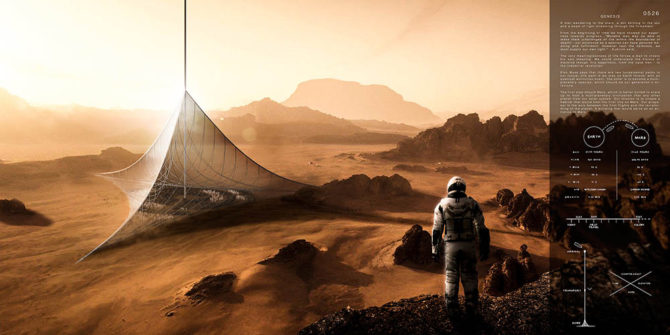
From the beginning of time we have shown our eagerness towards progress. “Mutable man may be able to make them (challenges of life within the boundaries of death) – our existence as a species can have genuine meaning and fulfillment. However, vast the darkness, we must supply our own light.” – Kubrick said.
The very meaninglessness of life forces a man to create his own meaning. We could understand the history of mankind though this eagerness, from the cave man – to the industrial revolution.
Elon Musk says there are two fundamental paths to our future, one path is we stay on Earth forever with an eventual extinction event. The other is to become a multi-planetary species, which should be our generation’s milestone. Dreaming for the stars
The first step should Mars, which is better suited to scale up to host a multi-planetary civilization that any other planet from our solar system. Our mission is to create a habitat that would host the first city on Mars. Our proposal is the axis between the first flights and the terraforming of the planet. A building that would serve as an entrance to Mars.
Before terraforming Mars we must think of an access to it. We propose a space elevator that would be composed of four elements. A counterweight to the top, a tent to the bottom, a tube that connects both elements and the elevator itself.
The counterweight would be located at a distance to which an object in the orbit moves at the same speed as the rotation of the planet. It would receive the spaceships and host the necessary laboratories in a radial composition. A skin covers the capsules and absorbs the solar energy far from the contamination of the atmosphere. It is a door to the habitat.
The tube would connect both the counterweight and the habitat on Mars. It must be strong enough to resist the traction produced by the rotation of the counterweight and wide enough to host the elevator.
“You need to live in a dome, initially”.
In order to make the planet habitable, we first start by creating a tent inside which life will start for the first time. At first, a small volume of oxygen will be separated from the abundant carbon dioxide in order to make the air breathable inside the tent. The soil would be transformed and vegetation would grow.
The tent is designed to grow larger as the population increases. It also has a radial composition that allows the dome to grow in all directions.
Go to the competition’s results page

